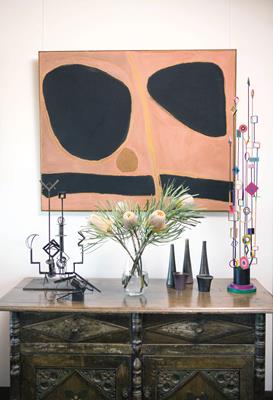ROVER THOMAS
THE LAVERTY COLLECTION - PART III
5 April 2017, Sydney
Djugamerri and Bolgumerri, 1991, is one of Rover Thomas’ landmark paintings that traverses the span of human history, from a Kimberley Aboriginal perspective, incorporating ancestral events with elements from modern times. Thomas’s identity as an Aboriginal male was multivalent but not unusual for the places and times in which he lived. Born of a Wangkajunga father and a Kukatja mother at Kunawarriji (Well 33) on the Canning Stock Route in the Great Sandy Desert, in his adult life, Rover Thomas traversed much of the eastern Kimberley, the Northern Territory and even into Queensland, as a stockman and fencer, eventually settling in the east Kimberley where he was inculcated into local Gija society. Rover was part of the diaspora of peoples into the Kimberley from the deserts to the south and southeast. Along with the people went a series of religious practices with their origins in the desert that infiltrated the Kimberley in modified forms.
The narrative behind this painting, as explained by Rover Thomas to Mary Macha in 1991, concerns the spirits of these two ancestors existing within two hills between Wyndham and Kununurra in the eastern Kimberley, close by Carlton Hill Station. The spirit of Bolgumerri (Bulkumerri or Pukulmirri, also known as House Roof Hill)1 appears as the black form at the top left of the painting, and Djugamerri (Djukamerri or Jukulmirri, False House Roof Hill) at the top right. The yellow vertical line separating these hills represents the road to Carlton Station that runs towards the Ord River (the black horizontal), while the smaller washed ovoid represents the location of a lockup, the ‘jail house…Police kept prisoners there’ of the sort that were established when the Kimberley was being settled by Europeans.
In this painting Rover Thomas draws an analogy between the two male ancestors and the two apical ancestors of the peoples of the western deserts, the Wati Kutjarra, who in various guises, travelled the land and laid down the laws of society and ritual, who gave order to the world.2 There are several Two Man narratives that criss-cross the Kimberley, including one that runs from west to east, that are modelled on the Wati Kutjarra. According to Rover, Bolgumerri and Djugamerri have been travelling through country belonging to the Bardi, Karajarri and Martu peoples where, respectively, the townships of Broome, La Grange and Jigalong now lie. This is country where the desert meets the sea in the far west of the Kimberley and beyond, south into the Great and Little Sandy Deserts.
The site depicted in the painting was visited by the spirit of Rover’s classificatory mother who died during Cyclone Tracy at the end of 1974. This is the spirit that revealed to Rover the public Kurirr Kurirr (Gurirr Gurirr, Krill Krill) ritual for which he was renowned. The woman had been fatally injured in a car crash on a flooded road near Turkey Creek and was being flown to hospital in Perth but died when the aeroplane was off the coast of Derby. From there, her spirit, accompanied by guiding spirits, travelled across the Kimberley from west to east, visiting places of significance; sacred and ceremonial places, massacre sites and burial grounds. The site appears in the songs of the Kurirr Kurirr cycle as recorded by Dr Will Christensen in 1983 and reproduced in Thomas, R., Roads Cross: The paintings of Rover Thomas, 1994:
Jukulmirri ngalirr kumpani Pukulmirri
(They [the woman and her guiding spirit] pass near Pukulmirri and Jukulmirri, large Dreaming hills on Carlton and Ivanhoe Stations. They continue to make songs as they go.)3
Pukulmirri and Kululmirri, Dreaming Hills, 1983, by Paddy Jaminji (1912 – 1996), in the Kurirr Kurirr series by Jaminji and Rover Thomas, in the collection of the National Gallery of Australia, depicts a similar compositional structure to Rover’s Djugamerri and Bolgumerri. In this painting, two arched forms seen in profile view, as opposed to the plan view in Rover’s painting, are separated by a series of verticals, one of which extends to surround one of the hills.4
Djugamerri and Bolgumerri was painted in Mary Macha’s studio in Subiaco, Perth. It is one of the few works Rover Thomas painted on Belgian linen. The work exudes a lush painterly quality and a richness of coloured pigment that characterise Rover Thomas’s most accomplished paintings.
1. House Roof Hill was the setting for the Faraway Downs homestead in the film Australia, directed by Baz Luhrmann
2. Wally Caruana in conversation with Rover Thomas, National Gallery of Australia, Canberra, 1994
3. Thomas, R., et al., Roads Cross: The paintings of Rover Thomas, National Gallery of Australia, Canberra, 1994, song 28, p. 27
4. ibid, p. 35
WALLY CARUANA
with thanks to Kim Akerman for his assistance in preparing this entry
